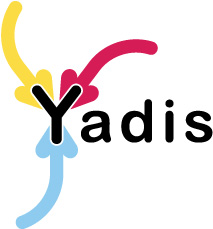A Uniform Resource Identifier (URI) is a unique sequence of characters that identifies a logical or physical resource used by web technologies. URIs may be used to identify anything, including real-world objects, such as people and places, concepts, or information resources such as web pages and books. Some URIs provide a means of locating and retrieving information resources on a network ; these are Uniform Resource Locators (URLs). A URL provides the location of the resource. A URI identifies the resource by name at the specified location or URL. Other URIs provide only a unique name, without a means of locating or retrieving the resource or information about it; these are Uniform Resource Names (URNs). The web technologies that use URIs are not limited to web browsers. URIs are used to identify anything described using the Resource Description Framework (RDF), for example, concepts that are part of an ontology defined using the Web Ontology Language (OWL), and people who are described using the Friend of a Friend vocabulary would each have an individual URI.
The Organization for the Advancement of Structured Information Standards is a nonprofit consortium that works on the development, convergence, and adoption of open standards for cybersecurity, blockchain, Internet of things (IoT), emergency management, cloud computing, legal data exchange, energy, content technologies, and other areas.
A Uniform Resource Name (URN) is a Uniform Resource Identifier (URI) that uses the urn scheme. URNs are globally unique persistent identifiers assigned within defined namespaces so they will be available for a long period of time, even after the resource which they identify ceases to exist or becomes unavailable. URNs cannot be used to directly locate an item and need not be resolvable, as they are simply templates that another parser may use to find an item.

A digital object identifier (DOI) is a persistent identifier or handle used to uniquely identify various objects, standardized by the International Organization for Standardization (ISO). DOIs are an implementation of the Handle System; they also fit within the URI system. They are widely used to identify academic, professional, and government information, such as journal articles, research reports, data sets, and official publications. DOIs have also been used to identify other types of information resources, such as commercial videos.
Extensible Name Service (XNS) is an open protocol for universal addressing and automated data exchange. It is an XML-based digital identity architecture.
i-numbers are a type of Internet identifier designed to solve the problem of how any web resource can have a persistent identity that never changes even when the web resource moves or changes its human-friendly name. For example, if a web page has an i-number, and links to that page use the i-number, then those links will not break even if the page is renamed, the website containing the page is completely reorganized, or the page is moved to another website.
I-names are one form of an XRI — an OASIS open standard for digital identifiers designed for sharing resources and data across domains and applications. I-names are human readable XRIs intended to be as easy as possible for people to remember and use. For example, a personal i-name could be =Mary or =Mary.Jones. An organizational i-name could be @Acme or @Acme.Corporation.

A DNS zone is a specific portion of the DNS namespace in the Domain Name System (DNS), which a specific organization or administrator manages. A DNS zone is an administrative space allowing more granular control of the DNS components, such as authoritative nameserver. The DNS is broken up into different zones, distinctly managed areas in the DNS namespace. DNS zones are not necessarily physically separated from one another; however, a DNS zone can contain multiple subdomains, and multiple zones can exist on the same server.
A Name Authority Pointer (NAPTR) is a type of resource record in the Domain Name System of the Internet.
XML namespaces are used for providing uniquely named elements and attributes in an XML document. They are defined in a W3C recommendation. An XML instance may contain element or attribute names from more than one XML vocabulary. If each vocabulary is given a namespace, the ambiguity between identically named elements or attributes can be resolved.

Yadis is a communications protocol for discovery of services such as OpenID, OAuth, and XDI connected to a Yadis ID. While intended to discover digital identity services, Yadis is not restricted to those. Other services can easily be included.
Life Science Identifiers are a way to name and locate pieces of information on the web. Essentially, an LSID is a unique identifier for some data, and the LSID protocol specifies a standard way to locate the data. They are a little like DOIs used by many publishers.

Michael Mealling is co-founder of Pipefish Inc, and was the cofounder, Chief Financial Officer (CFO) and Vice President of Business Development of Masten Space Systems, CEO of Refactored Networks, long time participant within the IETF, a Space Frontier Foundation Advocate, and a former Director of the Moon Society. He operates a blog site called Rocketforge and has been interviewed twice on The Space Show and twice on SpaceVidcast.
Security Assertion Markup Language (SAML) is an XML standard for exchanging authentication and authorization data between security domains. SAML is a product of the OASIS (organization) Security Services Technical Committee.
Security Assertion Markup Language 2.0 (SAML 2.0) is a version of the SAML standard for exchanging authentication and authorization identities between security domains. SAML 2.0 is an XML-based protocol that uses security tokens containing assertions to pass information about a principal between a SAML authority, named an Identity Provider, and a SAML consumer, named a Service Provider. SAML 2.0 enables web-based, cross-domain single sign-on (SSO), which helps reduce the administrative overhead of distributing multiple authentication tokens to the user. SAML 2.0 was ratified as an OASIS Standard in March 2005, replacing SAML 1.1. The critical aspects of SAML 2.0 are covered in detail in the official documents SAMLCore, SAMLBind, SAMLProf, and SAMLMeta.
A Formal Public Identifier (FPI) is a short piece of text with a particular structure that may be used to uniquely identify a product, specification or document. FPIs were introduced as part of Standard Generalized Markup Language (SGML), and serve particular purposes in formats historically derived from SGML. Some of their most common uses are as part of document type declarations (DOCTYPEs) and document type definitions (DTDs) in SGML, XML and historically HTML, but they are also used in the vCard and iCalendar file formats to identify the software product which generated the file.
The Handle System is the Corporation for National Research Initiatives's proprietary registry assigning persistent identifiers, or handles, to information resources, and for resolving "those handles into the information necessary to locate, access, and otherwise make use of the resources".
The Abbreviated Language for Authorization (ALFA) is a domain-specific language used in the formulation of access-control policies.
The SAML metadata standard belongs to the family of XML-based standards known as the Security Assertion Markup Language (SAML) published by OASIS in 2005. A SAML metadata document describes a SAML deployment such as a SAML identity provider or a SAML service provider. Deployments share metadata to establish a baseline of trust and interoperability.



